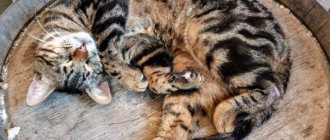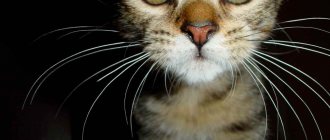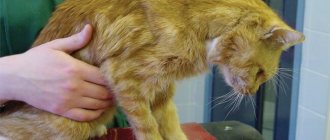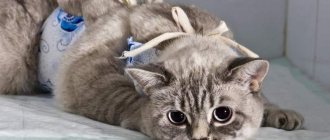Normal frequency of urination in cats
Those who have just bought themselves a mustachioed and striped friend often ask how many times a day a cat should pee. These animals initially existed with a lack of moisture, so they drink little, and their urine is extremely concentrated. Actually, this is what causes the specific and well-recognized smell of cat urine.
There is no need to be alarmed if your cat does not pee several times a day; it may happen once or twice a day. In principle, this is within normal limits, especially if the animal receives wet food and drinks very rarely and little.
This primarily applies to small kittens. Their urine is separated in minute quantities due to the fact that they feed on liquid food - mother's milk, which is almost completely absorbed by the kitten.
In addition, a caring cat constantly licks her kittens, so it may seem as if they are not urinating at all. Only after children begin to feed themselves can owners notice that they go to the toilet infrequently. This is also the norm for animals up to one and a half to two months.
It’s another matter if owners notice urinary problems in older animals. Normally, they can urinate 1 to 2 times a day. Frequent urination may indicate the presence of chronic renal failure (CRF), and too infrequent urination may indicate various health problems, including urolithiasis, which is very dangerous for cats.
Do I need to call the vet?
Your cat may check a couple of these boxes, but the disease can also happen to those who don't fit that mold. What symptoms may indicate the development of bladder obstruction?
Very often, your cat may feel a little uncomfortable for a few days and may not eat or drink as well as usual. You might just feel like they're a little off.
Although sometimes there may be no warning. They go from normal to emergency in the blink of an eye.
Symptoms
If you notice any of the following, contact your veterinarian immediately:
- frequent trips to the garbage tray
- spend more time squatting without producing urine
- urine with a red tint
- crying or screaming, especially when urinating (or trying)
- increased arousal and restlessness
- often licking their backside
- pain when lifting under the stomach
© shutterstock
As the disease progresses, your cat may begin to vomit, lose consciousness, go into a coma, and eventually die.
Causes of urinary problems
There are many reasons why a cat does not pee as it should, so diagnosing the disease is very important. Only after receiving accurate results can the doctor prescribe the correct treatment.
The most common causes of difficulty urinating are:
- Kidney diseases. There are quite a few of them, they can be congenital or acquired, appear as a result of injury or disease.
- Urolithiasis disease. This is the most common and dangerous cause of urinary obstruction.
- Cystitis, or inflammation of the bladder and urethra. Occurs during infection or as a consequence of hypothermia against the background of a decrease in immunity.
- Atony of the bladder, appearing after injury, surgery, as a result of illness or old age.
- Anuria (lack of urine) is a critical condition, often leading to the death of the animal.
- Complications on the kidneys after infectious or systemic diseases.
- Spinal injuries with spinal cord damage.
- Formation of tumors (benign or malignant).
INTERESTING TO KNOW: Why is gingivitis dangerous in cats?
In any case, if the cat cannot pee, contacting a veterinary clinic is vital, since without an accurate diagnosis it will be impossible to carry out the correct treatment.
When to contact a veterinarian
The topic of infrequent urination in cats comes up quite often. However, sometimes owners simply cannot keep track of how often their pet pees. Most often, difficulties in this matter arise if the cat goes outside.
If you rarely let your cat drink, she may also have trouble urinating. She will not urinate much due to dehydration. Therefore, first of all, if you notice that your cat hardly pees, you need to make sure that there is always water available to her. If after this the symptom disappears, then there is no need to go to the veterinarian.
© shutterstock
Contacting him becomes inevitable if such symptoms are noted.:
- During urination, the cat screams or meows loudly.
- The cat pees too little or too much.
- The consistency, color or odor of the secreted fluid has changed.
- The cat became lethargic and sleepy.
- The animal refuses water or suffers from constant thirst.
- The pet's temperature rises.
These signs can be observed if the cat cannot go to the toilet for more than a day.
Signs of problems with the urinary system
If the owner notices that his cat cannot pee, spins around in the tray, sits down, but nothing happens, this is a reason for serious concern and a visit to the veterinary clinic.
Any signs of trouble should be of concern - “empty” visits to the tray, screams or meowing during urination, small or excessively large amounts of urine, changes in its color and smell, the appearance of turbidity, flakes, sand or traces of blood in it.
Urinary disorders may be accompanied by increased lethargy of the animal, severe thirst or refusal to drink and/or eat, high or slightly elevated temperature, and drowsiness. Often a sick animal hides in a corner, stops playing, may scream pitifully or even growl at its owners when they try to feel it, sometimes the cat meows when they try to pick it up.
If a cat does not pass urine for a long time (more than a day), and the condition is accompanied by the symptoms described above, it must be urgently taken to a veterinary clinic. Such manifestations can be signs of serious diseases; the introduction of stones or tightly packed sand into the ureters or urinary tract is especially dangerous. Delay can cost the animal its health or even its life.
Forecast
Modern technologies and advanced techniques used in our clinic guarantee favorable prognoses in the vast majority of cases of treatment of urinary retention.
In our center, ischuria is successfully treated - effective and timely treatment aimed at eliminating its causes gives positive results, and relapses of the pathology practically do not occur.
If you are alerted by the first alarming symptoms, do not waste time: call us, make an appointment - our doctors are always ready to help you!
Treatment options
In cases where the cat does not pee, only a veterinarian can decide on the choice of treatment. In a number of situations, only the fastest surgical intervention can save the life of an animal, so you cannot hesitate in such a situation.
Very often, owners are interested in what to do if the cat cannot pee. The animal must be shown to the veterinarian and await his conclusion. Depending on the disease, specific treatment will be prescribed.
If the disease is bacterial in nature, antibiotics will have to be used; in other cases, antiviral, anti-inflammatory, painkillers, diuretics, antihistamines and other drugs, as well as steroid hormones (if required), will be prescribed. These drugs must be given strictly according to doctor's orders.
A sick cat needs love, affection, a warm, cozy place to sleep, and proper feeding and drinking regimen. She will need a special diet of foods that cannot irritate diseased kidneys and urinary organs.
Dry food, especially cheap food, must be removed from her diet. It is not of high quality and has an extremely negative effect on urinary function. It contains few natural products, especially meat, and mainly contains carbohydrates, fats, various additives, flavors that attract cats, and dyes.
In addition, it contains a lot of salt, and swelling in the cat’s stomach, such food severely dehydrates the body. Long-term feeding of such foods in itself can lead to impaired kidney function, and in the presence of a disease this is especially dangerous.
During an acute condition, the kidneys should not be overloaded with protein foods, so a lot of attention should be paid to the cat’s nutrition. Until the condition stabilizes, her food should be light, natural, unprocessed and sufficient in calories.
Since urolithiasis in cats is a fairly common phenomenon, and it mostly affects cats, especially castrated cats, urethrostomy is used as a preventive or therapeutic measure. Due to the severe narrowing of the urethra at the exit, even a small amount of sand can lead to the death of the cat. The new urethral opening is created between the scrotum and the anus.
This operation can save the animal’s life, but will require more attention and care from the owners, since the frequency of bacterial cystitis can triple.
Prevention
Prevention of the development of ischuria is timely diagnosis and elimination of its causes.
To prevent the development of the disorder, contact a specialist at the first symptoms.
For the purpose of prevention, it is advisable for men over 45 years of age to undergo an examination by a urologist annually, as well as a urine test and ultrasound of the genitourinary organs.
The risk group also includes women who have given birth and had abortions many times, and those representatives of the fairer sex who have undergone gynecological operations or suffer from diseases of the pelvic organs. These women should also visit a urologist once a year.
FAQ
After ejaculation I want to pee, but I can’t. This is fine?
— During an erection, it is normally difficult to urinate. If the erection has passed, but it is still difficult to urinate, it is worth dealing with this in person.
Over the past two years, a not very pleasant problem has appeared. Two or three times during this period, before menstruation there is urinary retention and obvious swelling under the eyes. With menstruation, a lot of fluid is released. What needs to be examined and what is the reason?
- This is how premenstrual syndrome manifests itself. If these symptoms cause concern, then you can take diuretics on such days.
Ask a Question
The kitten cannot go to the toilet
Little kittens do not go to the toilet on their own for more than 3 weeks after birth. The motor muscles of the baby's genitourinary system are not yet formed. The mother cat stimulates the elimination of urine and feces with a massage, licking the kittens' perineum and tummy. When the baby is one month old, he begins to urinate on his own 7-9 times a day. As you get older, the frequency of urination decreases up to 3-5 times.
Need to know! If an animal does not go to the toilet for a day, its body begins to smell unpleasant. Contact your veterinarian immediately.
Causes of urinary retention
The causes of the disease include colds, congenital anomalies, pathologies, and mental disorders.
Urinary retention is classified as:
- acute – complete cessation of urination, requires immediate medical intervention;
- chronic - urine is excreted in small portions, the bladder is not completely emptied.
Acute delay appears:
- in males – with prostatitis, prostatic hyperplasia;
- in females - with ectopic pregnancy, uterine prolapse.
The outflow of urine is impaired if the spinal cord and brain do not regulate the work of contractile muscles. This happens with spinal injuries, strokes, and spinal hernias. Males are more likely to suffer from this disease.
Reason 1. Urolithiasis
In animals, stones form in the urinary system - uroliths, oxalates. They close the urethral ducts, leading to the inability to urinate.
The development of the disease is promoted by:
- genetic predisposition of the breed;
- dehydration;
- sedentary lifestyle;
- unbalanced diet;
- increased levels of calcium in the blood.
When urine obstruction begins, animals begin to urinate frequently in small portions. When complete abstruation occurs, the urethra is blocked, the kitten cannot go to the toilet.
Urolithiasis often develops simultaneously with cystitis, because sand and stones injure the mucous membrane of the ducts, causing an inflammatory process.
Need to know! The following should be excluded from the diet of animals with a predisposition to urolithiasis:
- fish - phosphorus promotes the formation of stones;
- raw meat thickens and urine is more difficult to excrete;
- milk – contains magnesium, which prevents the flow of urine.
Animals are fed food with a high content of vitamins A, B, and glutamic acid.
Reason 2. Anuria
In kidney failure, organs lose their ability to produce urine. The acid-base metabolism and water-acid balance of the body are disrupted, which leads to intoxication.
Anuria occurs due to:
- heart failure;
- dehydration;
- taking medications, anesthesia;
- high blood pressure, blood clots;
- infections.
Anuria is a fatal stage of renal failure. With it, the kitten does not even feel the urge to urinate. A small chance of survival is possible if medical care is provided in a timely manner.
Reason 3. Cystitis
Cystitis develops against the background of infection in the bladder, obesity, exhaustion, mechanical damage to the urethra, hypothermia, weakened immunity, and stress.
Chronic cystitis is the most dangerous because it is asymptomatic. The chronic disease is incurable, so you must not miss the onset of acute cystitis, which has alarming signs.
Manifestation of the disease:
- dark colored urine with an unpleasant odor;
- swollen, hard belly, painful to the touch;
- elevated body temperature.
The kitten often comes to the toilet, trying to urinate, but to no avail. This behavior is caused by a painful inflammatory process.
For prevention, it is necessary to vaccinate the animal on time, avoid drafts and hypothermia.
Nutrition
Difficulties with the toilet are observed in cats that eat exclusively dry food. The risk increases if the animal is lazy, sedentary, and drinks little water. Urine gradually becomes thick, crystallizes, and urolithiasis develops.
Advice! Correct the kitten's nutrition from an early age.
Castration
After the operation, there is no natural emptying of the bladder for several days. Postoperative stress and caterization affect the psychological state of the cat and lead to further disruption of excretory functions.
After sterilization or castration, the metabolism of animals slows down, obesity appears, as a result, urolithiasis develops, and problems with the toilet begin.
Symptoms of difficulty urinating
You can notice the first signs of the disease by your pet’s behavior:
- walks around the toilet, meows pitifully;
- puts his paws in the tray and immediately comes out of it;
- meows painfully when trying to urinate;
- uncharacteristically stretches out its paws while licking itself;
- after trying to urinate, drops of blood remain on the toilet;
- dark-colored urine with a foul odor;
- the peritoneum is tense, the abdomen is painful.
The cat's tense posture when trying to go to the toilet and refusal to contact the owners should be alarming.
First aid
If the kitten cannot pass urine, it is examined independently and the bladder is carefully palpated. If the organ is compacted, enlarged, or the cat reacts painfully, contact a veterinarian immediately.
Before the doctor arrives:
- apply a heating pad to the pet’s stomach;
- give water to drink;
- instead of food they give chicken broth;
- lower the cat's lower body into a warm bath.
You can’t massage your cat’s belly – if stones are stuck in the ducts, this will lead to injury to the walls of the bladder.
It is prohibited to give painkillers, antispasmodics and other medications without a doctor’s prescription.
To drain urine, the doctor will insert a catheter into the kitten and prescribe further treatment. When remission occurs, the pet is given an infusion of sage, rose hips, horsetail, and plantain.
Need to know! Some animals are attracted to moving water. If a cat drinks little water, install a special fountain for it or periodically open the tap.
Diagnostic methods
Without an accurate diagnosis, starting treatment is prohibited. It is important to conduct a full examination of the cat in a clinical setting before drawing up a treatment plan. Remember that even a veterinarian will not be able to reliably find out the pathology, its form and degree of development at home. Clinical examination, laboratory, ultrasound, X-ray examinations are required:
- The sound is determined by lightly tapping the abdomen (percussion) - normally it should be ringing. Palpation allows you to feel a full bladder.
- An x-ray and ultrasound reveal a dark formation of considerable size - this is a full bladder. If we are talking about anuria, then it will be empty, but greatly enlarged kidneys with signs of necrosis will be found.
- A computed tomogram is used in addition to ultrasound for a more detailed study of stones, tumors, and hyperplasia that lead to compression of the urinary tract.
- Urine examination (in case of acute retention, it is taken through catheterization) is necessary to identify infection, pus, blood impurities, as well as determine the type of stones in urolithiasis.
- A blood test is needed to assess the general condition of the cat, the presence of an inflammatory or intoxication process.
After a long (more than a day) delay in urination, it is better to leave cats for several days in the clinic’s hospital, so that if the exacerbation recurs, an emergency ultrasound can be performed, a catheter placed, or an IV with the necessary medications installed.









